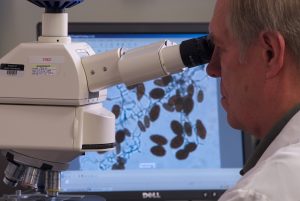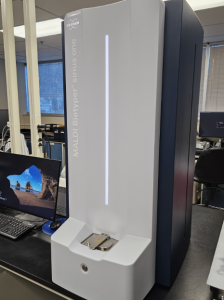Genetic Sequencing: The Gold Standard in Microbial Identification
For more than a decade, Nelson Laboratories has identified unknown microorganisms using genetic sequencing. This method involves the extraction of DNA from the cell, the amplification and sequencing of a specific gene, and the comparison of the resulting sequence to various databases.
This method has historically been considered the “gold standard” in microbial identification, and in many ways it still is. It is highly accurate and can successfully identify most of the microorganisms encountered in our industry. Working with DNA is ideal, because the sequences of certain essential genes remain relatively unchanged throughout an organism’s life cycle. There are no minimum or maximum growth requirements to identify an organism genetically.
However, genetic analysis is also very expensive and time consuming. Hands-on preparation and testing can span most of a typical workday, and the analysis itself runs several hours overnight.
MALDI-TOF: A New Approach to Microbial Identification
A new microbial identification method has recently gained popularity in the pharmaceutical industry. This method is known as matrix-assisted laser desorption/ionization time of flight (MALDI-TOF). This approach to identification bypasses DNA entirely and instead uses mass spectrometry to analyze proteins extracted from unknown microorganisms.
This method of identification is far quicker—results are generated in a matter of minutes. This new identification method has been validated at Nelson Labs and is currently in operation.
Preparing Samples for MALDI-TOF Analysis
The process begins by streaking the unknown organism to obtain a fresh culture. MALDI-TOF analysis must be performed on very young growth—generally 1-2 days of incubation is sufficient. At this stage of the organism’s life cycle, protein production is at its peak and secondary growth characteristics that may interfere with the analysis have not yet formed.
Once there is sufficient growth for analysis, two methods are available for preparing samples for testing:
-
Direct Smear Method
- A portion of the unknown colony is applied to a specialized reaction plate and overlaid with a 70% solution of formic acid. This facilitates the breakdown of cell walls and releases cellular proteins. A chemical matrix is then applied to the sample which, when activated by laser, assists in ionizing and desorbing the protein molecules.
-
Extraction Method
-
Proteins are extracted from the organism using sequential treatments with ethanol, 70% formic acid, and acetonitrile. The protein extract is then applied to the reaction plate and overlaid with the chemical matrix. This extraction method is required for filamentous mold. While more time-consuming than the direct smear method, the extraction method often results in more reliable spectra.
-
How MALDI-TOF Identifies Microorganisms
During analysis on the MALDI-TOF instrument, a laser irradiates the sample, triggering the desorption of ionized protein molecules into a gas column which travels through a mass spectrometer. The proteins are separated based on their mass-to-charge ratio—smaller proteins travel faster toward the detector than larger proteins.
A spectrum is generated based on a plot between the mass-to-charge ratio and signal intensity. This spectrum is then compared with a database of known spectra to determine the species.
The Nelson Labs MALDI-TOF instrument is connected to the Axcess® MALDI-TOF database, administered by Charles River Laboratories. This is the largest curated database of MALDI-TOF spectra relevant to the medical device and pharmaceutical industries, containing species that occur frequently in aseptic and sterile manufacturing environments.
The Advantages of MALDI-TOF Technology
The main advantage of the MALDI-TOF system is its speed. Sample preparation is less labor-intensive than genetic analysis, and results are available in minutes.
However, the Axcess® MALDI-TOF database may not contain a match for every organism encountered by the lab. If a match is not found using the MALDI-TOF system, the organism can be immediately analyzed on our existing genetic analyzers.
By using both technologies together, Nelson Labs will be able to more efficiently deliver the high-quality identification services our customers deserve.
Connect with Nelson Labs for Expert Microbial ID Solutions
If you have additional questions about Microbial Identification test services or would like to consult with the experts at Nelson Labs, just send us a request or call us at +1 (801)-290-7500.





